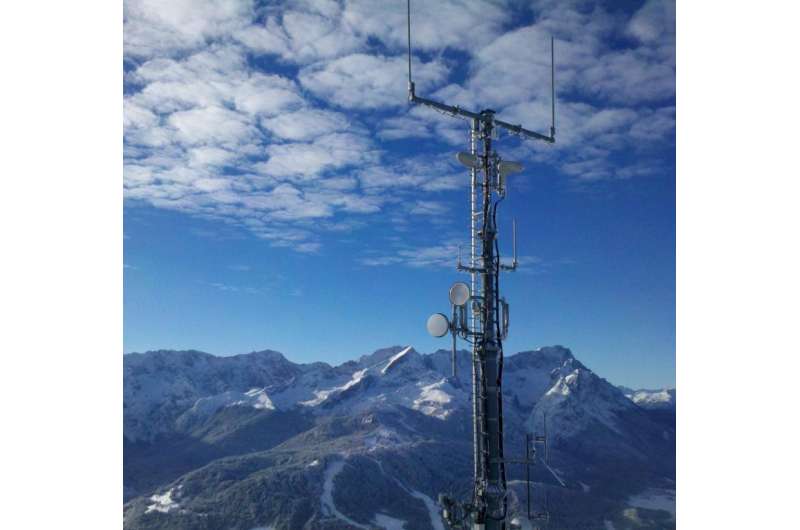Mobile radio network measures rainfall

Raindrops attenuate propagation of electromagnetic waves. Using specially developed software, researchers can derive information on rainfall from radiation fluctuations along radio links of mobile radio networks. This technique complements conventional measurements and might be applied for water management in countries with a few weather stations only.
Usually, meteorologists determine the amount of rain within a certain period of time with the help of automatic rain gauges or by a rain radar. Using the new technique, radiation fluctuations between transmission masts of mobile radio network operators are evaluated to find out where how much rain falls. Scientists of the Institute of Meteorology and Climate Research (IMK-IFU) of KIT in Garmisch-Partenkirchen have been studying this technique in Germany since 2010. The advantage is that it supplies information on local rainfalls with a minimum delay only. In addition, the closely meshed network of mobile masts ensures high regional coverage with measurements.
"Raindrops are about as large as the wavelength of microwave radiation of radio links operated at a frequency of 15 or 40 gigahertz. For this reason, they strongly attenuate radiation in this frequency range," Professor Harald Kunstmann of IMK-IFU explains. The stronger rainfall is, the more does the power decrease between two antennas. Mobile phone users hardly notice this effect on the radio signal. Only in case of extremely strong rain may radiation be attenuated to such an extent that communication between mobile transmission masts and, hence, telephone connection is interrupted. For the researchers, these fluctuations are sufficient to determine from the attenuation rates where how much rain falls.
Sensitivity of the measurement method is as high as when using the classical method of rain gauges. "The detection limit is rain rate of one millimeter per hour, data are available with a delay of one minute only," Dr. Christian Chwala, member of Kunstmann's research team, adds. Due to the special structure of snow, however, this method cannot be used for this type of precipitation.
The technique was tested using the attenuation rates of 450 radio links in southern Bavaria. The data are transmitted directly from the computing center of the cooperation partner Ericsson Deutschland to the climate researchers on KIT's Campus Alpine. There, the data are processed and searched for conspicuous power fluctuations. The researchers only need the transmission and reception powers of the radio links. Sensitive information, such as details of the communication transmitted, is not collected.
The corresponding studies were funded by the German Research Foundation (DFG) with a total of EUR 600,000 for two years under the project "Integrating Microwave Link Data for Analysis of Precipitation in Complex Terrain: Theoretical Aspects and Hydrometeorological Applications" (IMAP). The project is part of a trilateral cooperation with institutions in Israel and Palestine. An extension of the project for another three years has been applied for, the objective being to extend the number of evaluated radio links, to improve the quality of automatic data evaluation, and to use the information for flood prognosis. Work is also supported by the Stiftung Energieforschung Baden-Württemberg (Baden-Württemberg Energy Research Foundation).
"In Germany, there are about 1000 measurement points for precipitation, but roughly 100,000 radio links that might theoretically be used for measurement," Dr. Felix Keis, also a member of the research team, explains. Use of the new measurement technique might allow for quicker flood warnings in mountain regions. "But above all, the method is of high potential for countries, where there are a few or no weather stations or rain radars, but a dense mobile radio network," Harald Kunstmann says. In regions like West Africa, the measurement method might contribute to obtaining more precipitation information to improve the prognosis models urgently required for water resources management. Under the direction of KIT, international researchers are presently establishing contacts to West African scientists and radio network operators, among others in Ghana and Burkina Faso, to promote this innovative method.
More information: www.atmos-meas-tech.net/9/991/2016/
Provided by Karlsruhe Institute of Technology





















